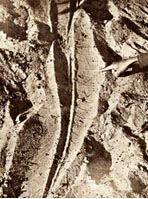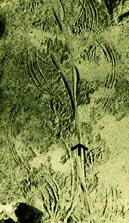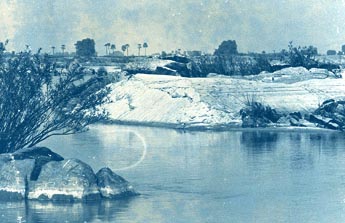CONTENTS
Feeding signs for species identification:
Faecal pellets as field evidences:
Using head impressions for size estimation:
Using hind pugmark for size estimation:
Using tail scute spoor for size estimation:
Distinguishing tracks of crocodilians, turtles and otters:
Tracks of 'high-walk' to distinguish gharial and mugger:
Further references:
Similipal Tiger Reserve: 2000
CROCODILE MONITORING
What to look for
Estimation of Body length
What to record during the field work
The various signs that may be available in the field for
interpretation are the spoor marks of head, body, tail and pug, the faecal
pellets and feeding signs. From these field evidences an idea can be obtained
about the sizes of crocodilians in the area. GO TOP
Feeding signs for species identification:
Feeding signs, particularly half-eaten fish, fish-heads and
dead fish with jaw marks are often met with in the field. These are, however,
difficult, except exceptional circumstances, to interprete for size of
crocodilians. This difficulty persists even when the gharial (Gavialis
gangeticus) and mugger (Crocodylus palustris) are occurring in the
same habitat although gharials have the characteristic long saw-like snout with
finer teeth than mugger. Only occasionally the jaw impressions on dead fishes
are very clear when a fish had escaped the jaw-hold of a gharial. GO TOP
Faecal pellets as field evidences:
Faecal pellets are very seldom found for gharial as they
defaecate mostly in water. Mugger pellets, however, are very common on the land.
When pellets are in proper shape, an idea can be obtained about the size or
age-class (juvenile, young adult, large adult etc.) of the crocodilian.GO TOP
Using head impressions for size estimation:
Head impressions on sand or mud can sometimes give an accurate
measurement for the total body length of the animal. The length of the lower jaw
is almost equal to the length of the head from snout-tip to the back of the
post-occipital scutes in gharial and mugger. In gharial the body size is roughly
five times this head length, and in the mugger it is about 6.5 (six and a half)
times. In saltwater crocodile (Crocodylus porosus) it is also six and a
half times. GO TOP
Using hind pugmark for size estimation:
mugger highwalk
 shows tailspoor between rows of front and hind paw spoor GO TOP
shows tailspoor between rows of front and hind paw spoor GO TOP
The clear pugmarks are usually of the hind limbs because of quadruped
locomotion. The hind pugmark is easy to interprete than the front pugmark, if
present. The hind pug consists of four digits � three clawed and one soft and
fleshy. On good substratum, the pugmark may even show the scute impressions from
which an otter pugmark can be separated out. Otter will not have the scutes but
have hairs. A pugmark selected for size interpretation must show the distance
between the heel and the point up to the beginning of the claws. The length of
the pug is about one twelfth to one fourteenth of the total body length in
mugger. Gharial pugs are relatively small. The use of hind pugmark length for
size estimation is more reliable in palustris than the use of tail scute length. GO TOP
Using tail scute spoor for size estimation:
gharial:tail scutes in ventral view
 gharial tail spoor
gharial tail spoor
 GO TOP
GO TOP
The most often met spoors in case of a crocodilian are the tail
spoors. These show characteristic curved lines running parallel to each other.
The space between two lines indicates the size of a ventral tail scute.
Measurements (length in mm) of at least two or three �large� scutes are required
to correctly interprete the size of gharials. The body length TBL=53.6+62.7(mean
scute length)mm. A thumb rule for field workers is TBL = 70 times the mean tail
scute length (in mm) in case of gharial. The relationship has not been
established in mugger and saltwater crocodiles. It is, however, approximately 65
(sixtyfive). The reason for this change from 70 to 65 appears to be related to
the number of caudal scutes. In gharial the number of such scutes is about 24
whereas, in mugger it is from 16-18, sometimes only 14 depending on a
geographical race of palustris. Hence, the size of each tail scute in
gharial is smaller than that of mugger. Therefore, the conversion factor for
scute length to TBL is higher in gharial than mugger.GO TOP
Distinguishing tracks of crocodilians, turtles and otters:
otter-track
 freshwater turtle-track
freshwater turtle-track

The body spoor is a sure indication to determine the species
when there is a possibility of confusion between gharial, mugger, otter and
turtles. To a new observer the drag impression from a log of wood may appear as
a crocodilian body drag. In such case the tail poor and pugmarks must be
searched.
A crocodilian track (of a juvenile), a turtle track and an
otter track may also appear similar to an untrained eye. Crocodilian body spoor
is accompanied with the impressions of scutes from the body, tail and pugs.
In a turtle track a tail drag may be there, particularly if it
is a male, but the pug marks are spaced apart over a small distance and these
draw two parallel impressions on either side of the body drag.
In an otter the tail drag may have a brooming effect due to the
hairs apart from the fact that the spoors due to moving pug are too much curved
inside.GO TOP
Tracks of 'high-walk' to distinguish gharial and mugger:
For gharial and mugger, when a tail drag is without a body
drag, it is that of a species that can perform a high walk. Gharials have weak
limbs and cannot lift their body to perform a �high walk� . Therefore, gharials
must leave their body spoor along with the tail track. In habitats where gharial
and mugger occur together it is a sure procedure to distinguish mugger tracks
from the gharial. But, if a tail drag is accompanied with body drag, for species
identification other visual indications are considered for species
identification.
gharial nesting site
 GO TOP
GO TOP
Further references:
(I)
Bustard, H. R. and Singh, L. A. K.(1977): Studies on the Indian Gharial
gangeticus (Gmelin) (Reptilia, Crocodilia)-I. Estimation of body length from
scute length. Indian Forester, 103(2):140-149.
Summary:
A basking gharial Gavialis gangeticus (Gmelin), often leaves at the
basking site, impressions of the single row tail scutes of the ventral region.
The growth of these scutes (SC) bear a linear relationship to the growth of the
total body length (TBL). TBL=53.658+62.733(SC). This statistic, with fair
degrees of accuracy, has been proved with four wild gharials and three captive
gharials ranging from 1.4 to 5.4m in total length. It is presumed that a similar
relationship exists for other crocodilian species too. This method of size
estimation from the tail scute spoor can be safely used for census and movement
studies.GO TOP
(2)
Singh, L. A. K. and Bustard, H. R. (1977): Locomotory behaviour during
basking and spoor formation in Gharial (Gavialis gangeticus. British Journal
of Herpetology, 5(9) : 673-676.
(3)
Singh, L. A. K. (1985): Notes on tracking and terrestrial activities of the
freshwater turtle Kachunga tentoria in river Mahanadi, Orissa. J.Bombay, nat.
Hist. Soc., 82(2) 414-417(1pl).
Similipal Tiger Reserve: 2000 CROCODILE MONITORING
What to look for
A..Basking crocodiles
Crocodiles, when left undisturbed, bask in the sun in the morning and
afternoon.
During winter days, they may bask for entire day.
Basking sites: islands, slopy banks near deep water.
- Signs for tunnels
Mugger crocodiles avoid very months and very hot seasons. They dig tunnels
and enter into it.
These tunnels open into water and have narrow mouth. Height of the mouth may
be
about 30-60cm. These may be upto 5 meters deep.
C. Body spoor
When a crocodile comes out for basking on sand and returns back to water it
will
Leave the marks of its body, tail and paws on the ground.
Estimation of Body length
A. From Direct sighting
Mention approximate total length from eye-estimation.
B. Body size from tracks
(1) From hind paw mark
body length = approx. 14xpaw length
(2) From tail mark
From lines drawn by tail-drag:
When a crocodile basks on land, because of movement of tail it draws
parallel
lines. The parallel lines are equal to the length of tail-scutes.
Body length =
approximately 65 times the maximum distance between two lines.
What to record during the field work
Date:-------------------- River System: -------------------------
Division----------------------------Range------------------------Section-----------Beat--------------------------
|
Place |
Body length |
Number of crocodiles
Directly seen |
Number of crocodiles identified from tracks |
Remarks:
(mention, whether tail track or paw mark were used) |
| |
|
|
|
|
| |
|
|
|
|